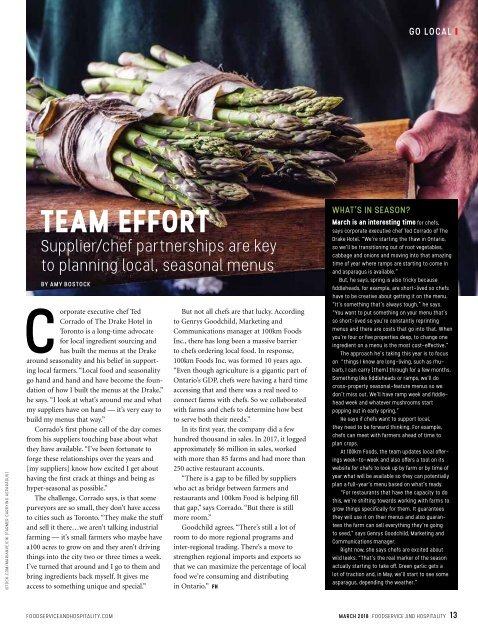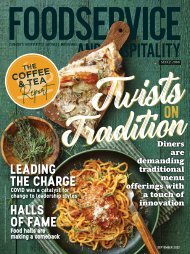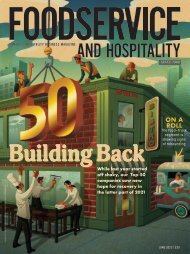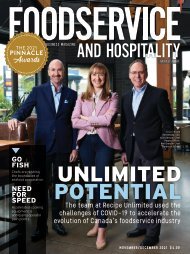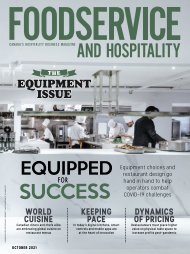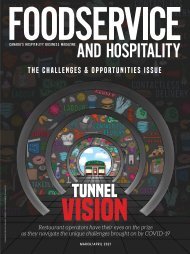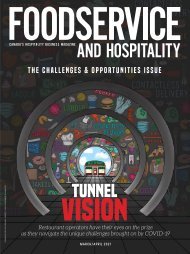March 2018 Digital Issue
Create successful ePaper yourself
Turn your PDF publications into a flip-book with our unique Google optimized e-Paper software.
GO LOCAL<br />
iSTOCK.COM/MARIANVEJCIK [FARMER CARRYING ASPARAGUS]<br />
TEAM EFFORT<br />
Supplier/chef partnerships are key<br />
to planning local, seasonal menus<br />
BY AMY BOSTOCK<br />
Corporate executive chef Ted<br />
Corrado of The Drake Hotel in<br />
Toronto is a long-time advocate<br />
for local ingredient sourcing and<br />
has built the menus at the Drake<br />
around seasonality and his belief in supporting<br />
local farmers. “Local food and seasonality<br />
go hand and hand and have become the foundation<br />
of how I built the menus at the Drake,”<br />
he says. “I look at what’s around me and what<br />
my suppliers have on hand — it’s very easy to<br />
build my menus that way.”<br />
Corrado’s first phone call of the day comes<br />
from his suppliers touching base about what<br />
they have available. “I’ve been fortunate to<br />
forge these relationships over the years and<br />
[my suppliers] know how excited I get about<br />
having the first crack at things and being as<br />
hyper-seasonal as possible.”<br />
The challenge, Corrado says, is that some<br />
purveyors are so small, they don’t have access<br />
to cities such as Toronto. “They make the stuff<br />
and sell it there…we aren’t talking industrial<br />
farming — it’s small farmers who maybe have<br />
a100 acres to grow on and they aren’t driving<br />
things into the city two or three times a week.<br />
I’ve turned that around and I go to them and<br />
bring ingredients back myself. It gives me<br />
access to something unique and special.”<br />
But not all chefs are that lucky. According<br />
to Genrys Goodchild, Marketing and<br />
Communications manager at 100km Foods<br />
Inc., there has long been a massive barrier<br />
to chefs ordering local food. In response,<br />
100km Foods Inc. was formed 10 years ago.<br />
“Even though agriculture is a gigantic part of<br />
Ontario’s GDP, chefs were having a hard time<br />
accessing that and there was a real need to<br />
connect farms with chefs. So we collaborated<br />
with farms and chefs to determine how best<br />
to serve both their needs.”<br />
In its first year, the company did a few<br />
hundred thousand in sales. In 2017, it logged<br />
approximately $6 million in sales, worked<br />
with more than 85 farms and had more than<br />
250 active restaurant accounts.<br />
“There is a gap to be filled by suppliers<br />
who act as bridge between farmers and<br />
restaurants and 100km Food is helping fill<br />
that gap,” says Corrado. “But there is still<br />
more room.”<br />
Goodchild agrees. “There’s still a lot of<br />
room to do more regional programs and<br />
inter-regional trading. There’s a move to<br />
strengthen regional imports and exports so<br />
that we can maximize the percentage of local<br />
food we’re consuming and distributing<br />
in Ontario.” FH<br />
WHAT’S IN SEASON?<br />
<strong>March</strong> is an interesting time for chefs,<br />
says corporate executive chef Ted Corrado of The<br />
Drake Hotel. “We’re starting the thaw in Ontario,<br />
so we’ll be transitioning out of root vegetables,<br />
cabbage and onions and moving into that amazing<br />
time of year where ramps are starting to come in<br />
and asparagus is available.”<br />
But, he says, spring is also tricky because<br />
fiddleheads, for example, are short-lived so chefs<br />
have to be creative about getting it on the menu.<br />
“It’s something that’s always tough,” he says.<br />
“You want to put something on your menu that’s<br />
so short-lived so you’re constantly reprinting<br />
menus and there are costs that go into that. When<br />
you’re four or five properties deep, to change one<br />
ingredient on a menu is the most cost-effective.”<br />
The approach he’s taking this year is to focus<br />
on “things I know are long-living, such as rhubarb,<br />
I can carry [them] through for a few months.<br />
Something like fiddleheads or ramps, we’ll do<br />
cross-property seasonal-feature menus so we<br />
don’t miss out. We’ll have ramp week and fiddlehead<br />
week and whatever mushrooms start<br />
popping out in early spring.”<br />
He says if chefs want to support local,<br />
they need to be forward thinking. For example,<br />
chefs can meet with farmers ahead of time to<br />
plan crops.<br />
At 100km Foods, the team updates local offerings<br />
week-to-week and also offers a tool on its<br />
website for chefs to look up by farm or by time of<br />
year what will be available so they can potentially<br />
plan a full-year’s menu based on what’s ready.<br />
“For restaurants that have the capacity to do<br />
this, we’re shifting towards working with farms to<br />
grow things specifically for them. It guarantees<br />
they will use it on their menus and also guarantees<br />
the farm can sell everything they’re going<br />
to seed,” says Genrys Goodchild, Marketing and<br />
Communications manager.<br />
Right now, she says chefs are excited about<br />
wild leeks. “That’s the real marker of the season<br />
actually starting to take off. Green garlic gets a<br />
lot of traction and, in May, we’ll start to see some<br />
asparagus, depending the weather.”<br />
FOODSERVICEANDHOSPITALITY.COM<br />
MARCH <strong>2018</strong> FOODSERVICE AND HOSPITALITY 13


